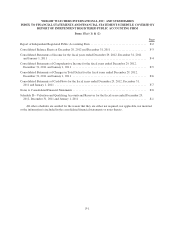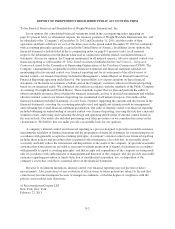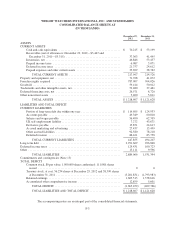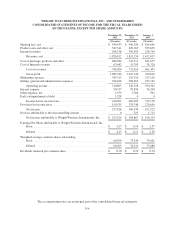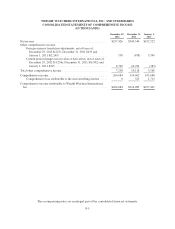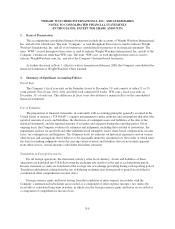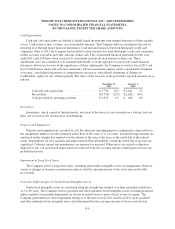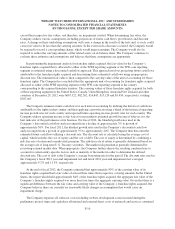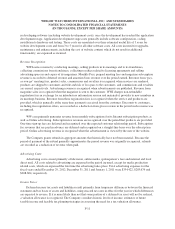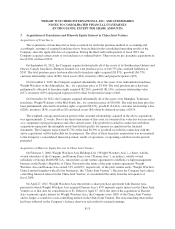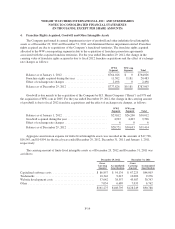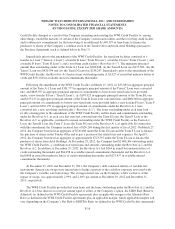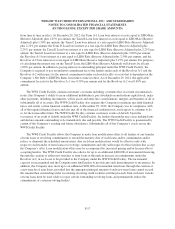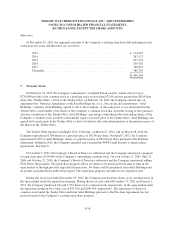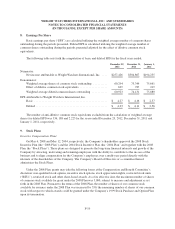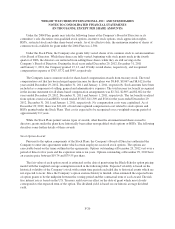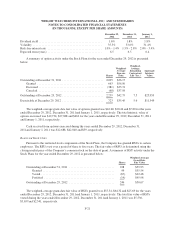WeightWatchers 2012 Annual Report Download - page 93
Download and view the complete annual report
Please find page 93 of the 2012 WeightWatchers annual report below. You can navigate through the pages in the report by either clicking on the pages listed below, or by using the keyword search tool below to find specific information within the annual report.WEIGHT WATCHERS INTERNATIONAL, INC. AND SUBSIDIARIES
NOTES TO CONSOLIDATED FINANCIAL STATEMENTS
(IN THOUSANDS, EXCEPT PER SHARE AMOUNTS)
in developing software (including website development costs), once the development has reached the application
development stage. Application development stage costs generally include software configuration, coding,
installation to hardware and testing. These costs are amortized over their estimated useful life of 3 years for
website development costs and from 3 to 5 years for all other software costs. All costs incurred for upgrades,
maintenance and enhancements, including the cost of website content, which do not result in additional
functionality, are expensed as incurred.
Revenue Recognition:
WWI earns revenue by conducting meetings, selling products in its meetings and to its franchisees,
collecting commissions from franchisees, collecting royalties related to licensing agreements and selling
advertising space in and copies of its magazines. Monthly Pass, prepaid meeting fees and magazine subscription
revenue is recorded to deferred revenue and amortized into revenue over the period earned. Revenue from “pay-
as-you-go” meeting fees, product sales, commissions and royalties is recognized when services are rendered,
products are shipped to customers and title and risk of loss pass to the customers, and commissions and royalties
are earned, respectively. Advertising revenue is recognized when advertisements are published. Revenue from
magazine sales is recognized when the magazine is sent to the customer. WWI charges non-refundable
registration fees in exchange for an introductory information session and materials it provides to new members in
its meetings business. Revenue from these registration fees is recognized when the service and products are
provided, which is generally at the same time payment is received from the customer. Discounts to customers,
including free registration offers, are recorded as a deduction from gross revenue in the period such revenue was
recognized.
WW.com primarily generates revenue from monthly subscriptions for its Internet subscription products as
well as Online advertising. Subscription fee revenues are recognized over the period that products are provided.
One-time sign-up fees are deferred and recognized over the expected customer relationship period. Subscription
fee revenues that are paid in advance are deferred and recognized on a straight-line basis over the subscription
period. Online advertising revenue is recognized when the advertisement is viewed by the user of the website.
The Company grants refunds in aggregate amounts that historically have not been material. Because the
period of payment of the refund generally approximates the period revenue was originally recognized, refunds
are recorded as a reduction of revenue when paid.
Advertising Costs:
Advertising costs consist primarily of television, online media, spokesperson’s fees and national and local
direct mail. All costs related to advertising are expensed in the period incurred, except for media production
related costs, which are expensed the first time the advertising takes place. Total advertising expenses for the
fiscal years ended December 29, 2012, December 31, 2011 and January 1, 2011 were $334,422, $283,674 and
$208,604, respectively.
Income Taxes:
Deferred income tax assets and liabilities result primarily from temporary differences between the financial
statement and tax bases of assets and liabilities, using enacted tax rates in effect for the year in which differences
are expected to reverse. If it is more likely than not that some portion of a deferred tax asset will not be realized,
a valuation allowance is recognized. The Company considers historic levels of income, estimates of future
taxable income and feasible tax planning strategies in assessing the need for a tax valuation allowance.
F-11


